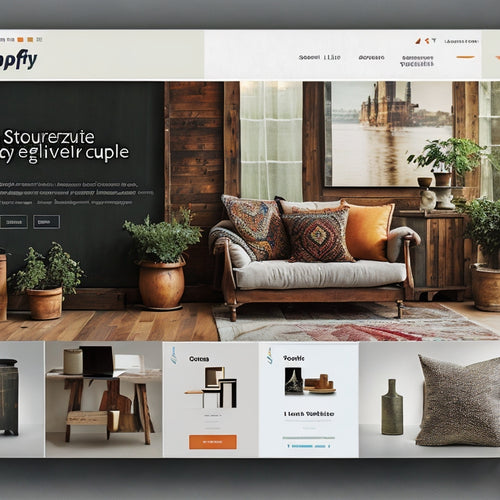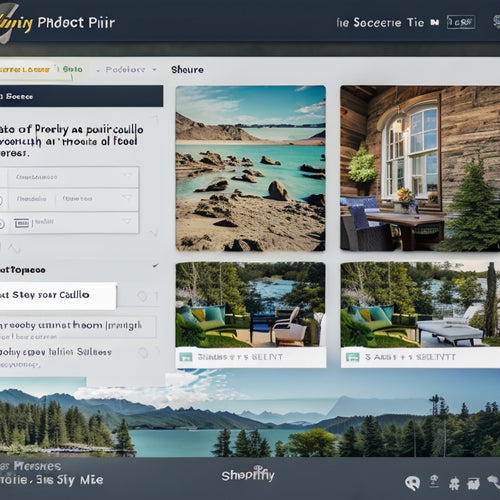Best Blog Apps for Shopify: Ultimate List
Share
This article aims to provide an objective analysis of the best blog apps available for Shopify. It will present a comprehensive list of options that can enhance the platform's blogging capabilities.
The subsequent sections will discuss the benefits of utilizing blog apps and offer tips for optimizing their performance.
Additionally, the article will provide helpful tutorials and resources for further learning on Shopify blog app optimization.
- Blog apps for Shopify can help increase website traffic through regular publication of informative and engaging content.
- These apps can improve SEO rankings by incorporating relevant keywords and optimizing meta tags.
- Blog apps facilitate easy content management for effective brand showcasing.
- By using blog apps, businesses can drive brand visibility and reach in the online marketplace.
Benefits of Blog Apps for Shopify
The utilization of blog apps for Shopify can offer various benefits to online businesses.
Firstly, these apps can help increase website traffic by providing a platform for regularly publishing informative and engaging content.
Secondly, they can contribute to better SEO rankings by incorporating relevant keywords and optimizing meta tags, thereby improving the visibility of the website in search engine results.
Additionally, blog apps enable enhanced customer engagement through features such as comments and social sharing options, while also facilitating easy content management for businesses to effectively showcase their brand and drive its visibility.
Increased Website Traffic
One important factor in improving website traffic is optimizing search engine visibility. By utilizing conversion rate optimization techniques and targeted audience segmentation, businesses can effectively increase their website traffic.
Conversion rate optimization refers to the process of enhancing a website's ability to convert visitors into customers or subscribers. This can be achieved through various strategies such as A/B testing, improving user experience, and implementing persuasive call-to-action buttons.
Targeted audience segmentation involves dividing a broader target audience into smaller, more specific groups based on demographics, behavior patterns, and preferences. By tailoring content and marketing messages specifically for these segmented audiences, businesses can attract more qualified visitors to their websites.
Ultimately, by focusing on conversion rate optimization and targeted audience segmentation, businesses can significantly improve their website traffic and ultimately achieve higher levels of success in the online marketplace.
Better SEO Rankings
Optimizing on-page elements, such as title tags and meta descriptions, is crucial for improving SEO rankings. On-page optimization focuses on optimizing the content and structure of a webpage to increase its visibility in search engine results.
Title tags provide concise descriptions of a webpage's content and help search engines understand its relevance to specific keywords. Meta descriptions provide brief summaries that appear in search engine result pages (SERPs) and influence click-through rates.
Link building strategies are also essential for improving SEO rankings. By acquiring high-quality backlinks from authoritative websites, a webpage gains credibility and signals to search engines that it is a reliable source of information. These links act as endorsements, indicating the page's value and increasing its chances of ranking higher in search results.
Incorporating both on-page optimization techniques and link building strategies can significantly improve a website's SEO rankings, leading to increased organic traffic and better visibility online.
Enhanced Customer Engagement
Enhanced customer engagement can be achieved by implementing interactive features and providing valuable content that encourages users to actively participate with a website.
Interactive content plays a crucial role in attracting and retaining customers. Studies have shown that interactive elements such as quizzes, polls, and surveys can increase user engagement and time spent on a website.
By involving customers in the content creation process through comments sections or user-generated content, businesses can foster a sense of community and loyalty among their audience. This not only enhances customer retention but also creates opportunities for valuable feedback and insights from customers.
Implementing interactive features also allows businesses to gather data on customer preferences and behaviors, which can inform future marketing strategies.
Overall, incorporating interactive content into websites is an effective approach to boost customer engagement and improve overall business performance.
Improved Brand Visibility
Improved brand visibility can be achieved by implementing effective marketing strategies that increase the reach and exposure of a business's brand to target audiences.
One key strategy for improving brand recognition is through the development and execution of a comprehensive content strategy. A well-planned content strategy allows businesses to create and distribute valuable, relevant, and consistent content that resonates with their target audience.
By delivering high-quality content through various channels such as websites, social media platforms, and email marketing campaigns, businesses can enhance their brand visibility and establish themselves as industry leaders.
Additionally, incorporating search engine optimization (SEO) techniques into the content strategy can further boost brand visibility by increasing organic traffic and improving search engine rankings.
Furthermore, data-driven analysis of consumer behavior can inform companies about the most effective channels for reaching their target audience, enabling them to refine their marketing efforts for maximum impact.
Easy Content Management
Transitioning from improved brand visibility, another important aspect of using blog apps for Shopify is easy content management. These apps provide users with various tools and features to create and manage their blog content effortlessly. With intuitive interfaces and user-friendly functionalities, these apps streamline the process of content creation, making it accessible to users with little to no technical skills.
Additionally, these apps often come equipped with advanced blog analytics capabilities that allow users to track the performance of their content in terms of engagement, traffic, and conversions. By analyzing this data, users can make informed decisions about their content strategy and optimize it for maximum impact.
Overall, these blog apps empower Shopify store owners to effectively manage their blog content and drive meaningful results for their business.
Tips for Blog App Optimization
This discussion will focus on several key points related to optimizing blog apps for maximum effectiveness.
The first area of consideration is SEO best practices, which involve implementing strategies to improve the visibility and ranking of blog content in search engine results.
Image optimization techniques will also be explored, as high-quality visuals can enhance reader engagement and contribute to overall website performance.
In addition, the importance of content formatting tips will be discussed, as well as the integration of social media platforms to amplify the reach and impact of blog posts.
SEO Best Practices
To optimize the visibility and ranking of a Shopify blog, it is crucial to implement SEO best practices. These techniques involve various strategies that focus on improving the blog's search engine performance.
One such strategy is keyword research, which involves identifying relevant keywords and incorporating them into the blog content. This helps attract organic traffic by aligning the blog with user search queries.
Additionally, optimizing meta tags, headings, and URLs can enhance the blog's visibility in search results.
It is also important to create high-quality content that engages readers and encourages them to share and link back to the blog.
Image Optimization Techniques
Implementing image optimization techniques is essential for improving the performance and visibility of images on a Shopify blog. One crucial technique is image compression, which reduces the file size without compromising visual quality. Compressed images load faster, resulting in improved page speed and user experience. Various tools are available to automatically compress images during the upload process, making it easier for bloggers to optimize their visuals.
Another important aspect of image optimization is alt text optimization. Alt text provides alternative information about an image for users who cannot see it or have visual impairments. By incorporating relevant keywords into alt text, bloggers can enhance the accessibility of their content while also improving search engine visibility.
Overall, employing effective image optimization techniques such as compression and alt text optimization can significantly enhance the performance and visibility of images on a Shopify blog. These practices not only improve user experience but also contribute to better search engine rankings and increased organic traffic to the blog.
Content Formatting Tips
Content formatting plays a significant role in enhancing the readability and accessibility of blog posts, allowing readers to easily navigate through the content and consume information effectively. Effective content formatting is crucial for engaging readers and promoting blog posts successfully.
When it comes to content creation, using headings, subheadings, bullet points, and numbered lists can help organize the information in a logical manner. These formatting elements not only break up large blocks of text but also provide visual cues that guide readers' attention. Additionally, incorporating relevant images, videos, or infographics can further enhance the appeal and engagement of the blog post.
Furthermore, ensuring proper spacing between paragraphs and utilizing font styles that are easy on the eyes can contribute to a pleasant reading experience.
In terms of blog promotion, well-formatted content has a higher chance of being shared on social media platforms or linked from other websites. With visually appealing and organized content, readers are more likely to spend time on the page and engage with it by leaving comments or sharing it with their networks. This increased engagement not only helps promote the blog post but also improves its visibility in search engine rankings.
Therefore, focusing on effective content formatting techniques is essential for successful content creation and blog promotion strategies.
Social Media Integration
Social media integration is a crucial aspect of modern content marketing strategies and can significantly enhance the reach and visibility of blog posts. By incorporating social media scheduling and analytics into their content strategy, businesses can effectively manage their online presence and maximize engagement with their target audience.
Social media scheduling allows for the strategic planning and automation of social media posts across various platforms. This ensures consistent and timely delivery of content, creating a seamless experience for followers. Moreover, it allows businesses to optimize posting times based on data-driven insights, maximizing the potential reach and impact of each post.
In addition to scheduling, social media analytics provide valuable insights into the performance of blog posts on different platforms. These analytics enable businesses to track key metrics such as reach, impressions, engagement, and conversions. By analyzing this data, marketers can identify trends, understand audience preferences, and refine their content strategy accordingly.
Overall, integrating social media into content marketing strategies through scheduling and analytics offers businesses a powerful means to expand their online presence and connect with their target audience in a more effective manner.
Helpful Tutorials for Shopify Blog Apps
A variety of tutorials are available to assist users in navigating and maximizing the functionality of Shopify blog apps. These helpful resources provide effective strategies for managing and optimizing a Shopify blog.
One such tutorial is the 'Shopify Blog App Tutorial' offered by Shopify itself. This tutorial provides step-by-step instructions on how to set up a blog, create and manage blog posts, customize the appearance of the blog, and utilize various features such as tags and categories.
Another valuable resource is the 'Advanced Shopify Blogging Tips' tutorial provided by experts in the field. This tutorial delves deeper into advanced strategies for improving SEO, increasing traffic, engaging with readers, and promoting products through blog posts.
For those looking to enhance their design skills, there are tutorials available that focus specifically on customizing the appearance of a Shopify blog. These tutorials provide guidance on selecting themes, modifying layouts, adding images and videos, and creating visually appealing content.
Overall, these tutorials offer users comprehensive guidance on utilizing Shopify blog apps effectively. By following these tutorials and implementing the suggested strategies, users can optimize their blogs' performance and achieve their desired objectives.
Learn More: Resources for Shopify Blog App Optimization
Numerous resources are available for users seeking to optimize the functionality of Shopify blog apps. These resources provide detailed information on various Shopify blog app features and customization options. By exploring these resources, users can enhance their understanding of the capabilities and potential of different blog apps, as well as learn how to customize them according to their specific needs.
One useful resource is the official Shopify documentation, which offers comprehensive guides and tutorials on using blog apps effectively. This documentation provides step-by-step instructions on setting up a blog, managing posts, optimizing SEO settings, and utilizing additional features such as tags and categories. Additionally, there are numerous online forums and communities where users can engage with experts and fellow Shopify store owners to seek advice and share experiences related to blog app optimization.
In addition to these general resources, many third-party websites offer in-depth reviews and comparisons of different Shopify blog apps. These reviews often analyze key features, such as layout options, social sharing integrations, search functionality, comment systems, and mobile responsiveness. Users can consult these reviews to gain insights into the strengths and weaknesses of various blog apps before making an informed decision based on their specific requirements.
Overall, by utilizing the available resources that focus on Shopify blog app features and customization options, users can maximize the potential of their blogs on the platform while ensuring a personalized experience tailored to their brand identity.
Frequently Asked Questions
How Much Does It Typically Cost to Use a Blog App for Shopify?
The cost of using a blog app for Shopify varies depending on the specific app and its features. There are both free and paid options available, with some apps offering additional features at a higher cost. A cost comparison can help determine the best option for individual needs.
Can I Use Multiple Blog Apps on My Shopify Store?
Using multiple blog apps on a Shopify store is possible, as Shopify allows integration of various apps. However, it is crucial to ensure seamless integration between the blog apps and other Shopify apps to avoid conflicts or compatibility issues.
Are There Any Limitations on the Number of Blog Posts I Can Publish Using a Blog App?
The number of blog posts that can be published using a blog app may have limitations. However, the benefits of using blog apps for Shopify include enhanced functionality and organization for managing and publishing content.
Can I Schedule Blog Posts to Be Published at a Specific Date and Time Using a Blog App?
A blog app with a scheduling feature allows users to set specific dates and times for their blog posts to be published. This feature offers convenience and flexibility, ensuring timely and organized content delivery.
Are There Any SEO Features Included in Blog Apps for Shopify?
SEO strategies and optimization techniques are commonly included in blog apps for Shopify. These features aim to improve website visibility, increase organic traffic, and enhance search engine rankings by implementing best practices for on-page optimization and keyword targeting.
Related Posts
-

What Are the Best Shopify SEO Strategies
The objective of this article is to analyze and present the best Shopify SEO strategies for e-commerce success. By e...
-

How Do I Add a Product Feed to Shopify
The integration of product feeds into Shopify offers numerous advantages for merchants seeking to enhance their onli...
-

Why Is My Shopify Site So Slow
This article aims to provide a comprehensive analysis of the factors contributing to the sluggishness of Shopify sit...


